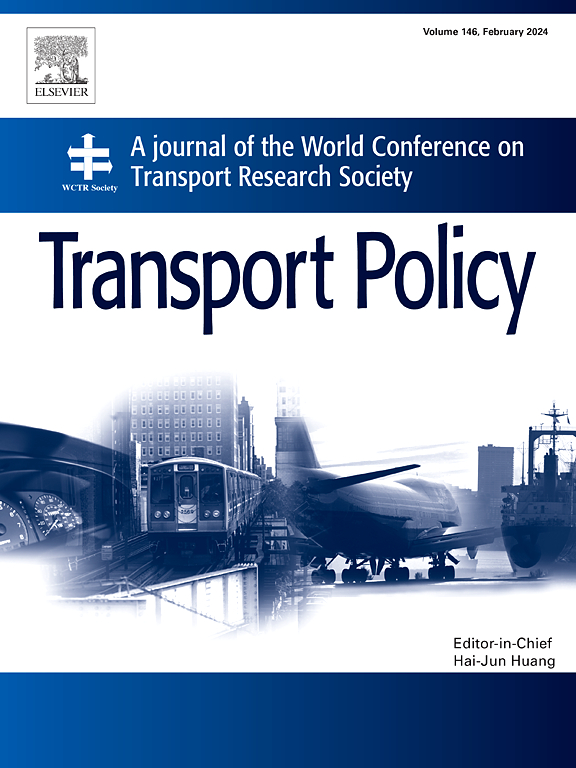衡量国际机场在2019冠状病毒病大流行之前和期间的效率和生产力变化
IF 6.3
2区 工程技术
Q1 ECONOMICS
引用次数: 0
摘要
在当今全球化的环境中,航空业是影响贸易、旅游和国民经济的重要经济支柱。考虑到2019冠状病毒病大流行和中美贸易战,本研究采用带保证区域(AR)的数据包膜分析(DEA)对2017 - 2021年19个国际机场的效率进行了测量,并应用马姆奎斯特生产率指数(MPI)分析生产率变化。机场的选择基于Skytrax的排名,输入因素包括跑道长度、航站楼面积和运营费用,输出因素包括乘客数量、货运量和总收入。主要调查结果显示,首尔仁川机场(ICN)、香港机场(HKG)、伦敦希思罗机场(LHR)、台湾桃园机场(TPE)和雅加达机场(CGK)的效率较高,与Skytrax的排名存在差异。在研究期间,19个机场的MPI下降了16%,表现出波动性和显著的下降。哥本哈根机场(CPH)、香港机场(HKG)、CGK机场和罗马菲乌米奇诺机场(FCO)取得了显著进展。2020-2021年的MPI几何平均值降至0.514,表明新冠肺炎对机场生产力产生了重大影响,技术进步推动了生产力的转变。此外,管理决策矩阵根据机场的相对总效率(AE)和效率变化(EC)得分将19个机场分为7类,其中香港机场、CGK机场和ICN机场表现出较高的竞争力和快速的进步;提出了在每个类别中提高或保持竞争优势的策略。本文的研究结果可以帮助机场管理者了解相对效率和改进方向,为未来的战略提供参考。本文章由计算机程序翻译,如有差异,请以英文原文为准。
Measuring the efficiency and productivity changes in international airports before and during the COVID-19 pandemic
In today's globalized environment, the aviation industry is a critical economic pillar that influences trade, tourism, and national economies. Accounting for the COVID-19 pandemic and the US‒China trade war, this study uses data envelopment analysis (DEA) with an assurance region (AR) to measure the efficiency of 19 international airports from 2017 to 2021 and applies the Malmquist productivity index (MPI) to analyze productivity changes. Airport selection is based on Skytrax rankings, with inputs including runway length, terminal area, and operational expenses, and outputs including the number of passengers, cargo volume, and total revenue. Key findings indicate that the Seoul Incheon (ICN), Hong Kong (HKG), London Heathrow (LHR), Taiwan Taoyuan (TPE), and Jakarta (CGK) airports were efficient, suggesting disparities with the Skytrax rankings. The MPI decreased by 16% across the 19 airports over the study period, with volatility and a notable decline. Noteworthy progress has occurred at the Copenhagen (CPH), HKG, CGK, and Rome Fiumicino (FCO) airports. The geometric mean of the MPI for 2020–2021 decreased to 0.514, indicating that COVID-19 had a significant impact on airport productivity, with technological advancements driving productivity shifts. Furthermore, a management decision matrix classified the 19 airports into seven categories based on their relative aggregate efficiency (AE) and efficiency change (EC) scores, with HKG, CGK, and ICN demonstrating high competitiveness and rapid progress; strategies for improving or maintaining a competitive advantage in each category are presented. The findings of this paper can help airport managers understand relative efficiency and improvement directions, serving as a reference for future strategies.
求助全文
通过发布文献求助,成功后即可免费获取论文全文。
去求助
来源期刊

Transport Policy
Multiple-
CiteScore
12.10
自引率
10.30%
发文量
282
期刊介绍:
Transport Policy is an international journal aimed at bridging the gap between theory and practice in transport. Its subject areas reflect the concerns of policymakers in government, industry, voluntary organisations and the public at large, providing independent, original and rigorous analysis to understand how policy decisions have been taken, monitor their effects, and suggest how they may be improved. The journal treats the transport sector comprehensively, and in the context of other sectors including energy, housing, industry and planning. All modes are covered: land, sea and air; road and rail; public and private; motorised and non-motorised; passenger and freight.
 求助内容:
求助内容: 应助结果提醒方式:
应助结果提醒方式:


